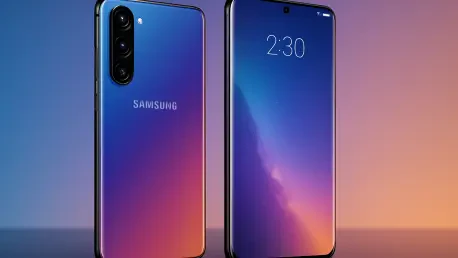Imagine a smartphone so thin it feels like a whisper in your hand, yet powerful enough to last through a demanding day of streaming, gaming, and multitasking. With Samsung’s rumored Galaxy S26 Edge on the horizon, set for release in just five months, the tech world is abuzz with speculation about whether this device can achieve the ultimate balance of sleek aesthetics and robust performance. This roundup dives into the latest leaks, industry opinions, and expert analyses to explore if the S26 Edge will set a new benchmark for slim design in the premium smartphone market. The focus is on its anticipated 5.5mm thickness and battery upgrades, compiling diverse perspectives to gauge if Samsung can truly redefine what a flagship device should be.
Setting the Stage for Samsung’s Latest Innovation
The Galaxy S26 Edge has sparked intense curiosity among tech enthusiasts, with leaks and rumors painting a picture of a device that aims to push boundaries. Reports suggest a release timeline of just five months, positioning this smartphone as Samsung’s answer to growing consumer demand for slimmer yet more capable devices. After feedback on the Galaxy S25 Edge highlighted dissatisfaction with its 3,900mAh battery, the industry is watching closely to see if Samsung can address these concerns while maintaining an ultra-thin profile.
Multiple sources point to the S26 Edge as a potential game-changer, with whispers of a design that could challenge competitors in the premium segment. Industry observers note that Samsung appears to be prioritizing a balance between cutting-edge aesthetics and practical functionality. This roundup seeks to unpack these expectations by collating varied insights on whether the company’s next big leap will resonate with users or fall short amid high stakes.
The conversation also extends to market dynamics, with many analysts suggesting that Samsung is under pressure to innovate in a landscape where thinness often equates to luxury. The consensus among tech blogs and forums is one of cautious excitement, as the S26 Edge could either solidify Samsung’s dominance or expose gaps in balancing design with performance. These differing views set the stage for a deeper dive into the device’s rumored specifications.
Unpacking the Galaxy S26 Edge’s Design Goals
Slimmer Than Ever: Targeting a 5.5mm Profile
The standout feature generating buzz around the S26 Edge is its rumored 5.5mm thickness, a notable 0.3mm reduction from its predecessor. Many industry watchers agree that this push for an ultra-slim design aligns with a broader trend of equating thinness with sophistication in flagship devices. However, opinions vary on whether such a marginal decrease will be noticeable or meaningful to the average user.
Some tech commentators express concern over potential trade-offs, questioning if shaving off fractions of a millimeter might affect the phone’s structural durability. Discussions on online platforms highlight fears of compromised ergonomics, with a few users suggesting that an overly thin device could feel less secure in hand during daily use. These reservations underscore a split in perception about the value of extreme slimness.
On the flip side, design-focused analysts argue that achieving a 5.5mm profile could cement Samsung’s reputation for innovation, especially if paired with premium materials. Comparisons to other brands rumored to target similar thicknesses fuel debates on whether this benchmark will become the new standard. The diversity of opinions reflects a broader uncertainty about how far slim design can be pushed without sacrificing practicality.
Battery Boost: Sorting Through Capacity Speculations
Battery life remains a critical pain point for smartphone users, and leaks about the S26 Edge suggest a capacity upgrade to somewhere between 4,200mAh and 4,400mAh, up from the S25 Edge’s 3,900mAh. Tech communities are split on the reliability of these figures, with some sources noting discrepancies that might reflect differences between rated and typical capacities. This uncertainty has sparked discussions on how much of an improvement users can realistically expect.
A segment of industry analysts emphasizes the importance of this upgrade, arguing that even a modest increase could significantly enhance user experience, especially for power-intensive tasks. However, others caution against over-optimism, pointing out that fitting a larger battery into a thinner frame poses engineering challenges. Skeptics wonder if Samsung might prioritize design over substantial power gains, leaving consumers wanting more.
Consumer feedback aggregated from forums reveals a strong desire for all-day battery life, with many hoping Samsung delivers on the higher end of the rumored range. The varied perspectives highlight a tension between expectation and feasibility, as the tech world awaits clearer data. This mix of hope and skepticism frames the ongoing narrative around the S26 Edge’s power capabilities.
Innovative Materials: Exploring Battery Tech Possibilities
Rumors of a “new battery material technology” for the S26 Edge have ignited curiosity across tech circles, though specifics remain elusive. Some industry insiders speculate that advancements like silicon-carbon compositions could be in play, potentially boosting energy density in a slim form factor. Others believe Samsung might simply be optimizing battery volume, a less revolutionary but practical approach.
Enthusiast communities are divided on the impact of such innovations, with a portion expressing excitement over the possibility of groundbreaking efficiency gains. However, more conservative voices argue that early-stage rumors often overpromise, and the technology might not be ready for mainstream adoption in the upcoming release. This split reflects a broader uncertainty about the pace of battery tech evolution.
Analysts tracking industry trends suggest that even incremental improvements in materials could position Samsung favorably against rivals, especially if paired with sustainable practices. The conversation around potential innovations underscores a collective hope for devices that don’t compromise power for design. As leaks continue to surface, these differing viewpoints keep the speculation alive on how transformative the S26 Edge’s battery tech might be.
Competitive Edge: Positioning in the Slim Design Race
In a market obsessed with sleek aesthetics, the S26 Edge’s rumored 5.5mm thickness places it directly in competition with other flagship devices targeting similar profiles. Industry comparisons often highlight parallel efforts by major players, noting that thinness has become a defining trait of premium smartphones. Many agree that Samsung’s focus on this metric is a strategic move to capture consumer attention in a crowded field.
Opinions differ on whether slim design alone can differentiate a device, with some market watchers arguing that durability and functionality hold equal weight in purchasing decisions. User discussions on social platforms reveal a preference for a balanced approach, where a thin profile doesn’t come at the expense of a robust build. This perspective challenges the notion that thinner always means better.
Looking at the competitive landscape, analysts suggest that Samsung’s dual emphasis on slimness and battery life could carve out a unique niche if executed well. Yet, there’s a counterargument that without standout features beyond thickness, the S26 Edge risks blending into the pack. These contrasting views illustrate the high stakes of standing out in an industry where design trends evolve rapidly.
Key Takeaways from Diverse Perspectives
Synthesizing the range of opinions, the Galaxy S26 Edge emerges as a device poised to address past criticisms with its anticipated 5.5mm profile and battery capacity hike to between 4,200mAh and 4,400mAh. Tech communities and analysts alike see these upgrades as steps toward meeting user demands for both style and substance. However, the fluctuating battery estimates and lack of concrete details on new technologies keep expectations in check.
Practical insights for consumers include keeping an eye on further leaks as the launch nears, since confirmed specifications will likely clarify the device’s true potential. There’s also a shared sentiment that Samsung should transparently communicate final battery figures to avoid disappointment. This compilation of views emphasizes the need for buyers to evaluate slim design against everyday usability when considering an upgrade.
Beyond individual opinions, the broader discourse suggests that the S26 Edge represents a critical test for Samsung’s ability to innovate under scrutiny. The mix of optimism and caution across sources highlights a collective curiosity about whether the device can deliver a meaningful leap forward. Consumers are encouraged to stay informed as more data emerges in the coming months.
Looking Ahead to Slim Smartphone Trends
Reflecting on the insights gathered, the discussions around the Galaxy S26 Edge reveal a tech landscape hungry for devices that harmonize aesthetics with performance. The varied perspectives underscore how Samsung navigates user feedback and competitive pressures to craft a device that aims to push boundaries. The focus on a 5.5mm thickness and enhanced battery capacity stands out as pivotal talking points in shaping expectations.
Moving forward, tech enthusiasts are advised to monitor official announcements and hands-on reviews for a clearer picture of the S26 Edge’s capabilities. For Samsung, the challenge remains to refine communication strategies and ensure that promised features translate into real-world benefits. This focus on transparency is seen as key to building trust with a discerning audience.
As the smartphone industry continues to evolve, the insights from this roundup suggest that innovation in slim design will remain a central theme. Exploring related trends, such as advancements in battery efficiency or material science, offers a pathway for deeper understanding. Staying engaged with emerging leaks and expert analyses is recommended as a way to anticipate how devices like the S26 Edge might shape future standards.









